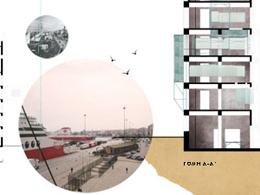STUDENTS PROJECTS
PROJECTS2013

02 July, 2014
TRACING THE BUILDING SHELL OF AN OLD FLOUR FACTORY IN PATRAS
Installation of an narrative route.
Students : Roula Kouvara, Ernestina Karystinaiou-Efthymiatou
Supervisor: Dimitris Giannishs
Consultants: Kostas Daflos, Vanda Chalyvopoulou
Architecture Department of Patras
Presentation date: 28/6/2013
This thesis proposes a narrative route that attempts to deliver to the visitor the "spirit" of an abandoned industrial building in "emergency" in the city of Patras , the ex-flour mills factory of St. George.
The construction of this route, which runs through the shell of the building is a spatial translation of a composition of different past inhabitations.
The building , originally a stone- mill , built in the mid 19th century used to function as a flour mill - industry of businesses Triantis Mills and St. George, as in 1990 , and was in 1991 purchased from the bus services of Patras. After purchasing the building, all mechanical equipment was removed, leaving inside only two machines. No kind of archive was saved. The years that followed, the building served as a refuge for immigrants, waiting to leave the port , like many other abandoned buildings in the coastal zone. Finally , the fifth floor of the building was reconstructed in 2006 , on the occasion of its use as a cultural area of cultural capital . The changes made were temporary but as the building is now in state of waiting.

Searching information about its function as a flour mill, we focused on its mechanical section, which shows how the building functioned. A clear path that crosses the height of the building became evident: pre-cleaning, cleaning, waiting, milling, storage.

In addition, different habitations of the building are visible at first glance like material traces on its shell: the perforated floors, the bus archives in the ground floor, the house of the guard dogs in the first floor, Arabic texts on the walls of the third and fourth floor. In the fifth floor one observes additions - made when the building functioned as a cultural space.
In order to organize and connect the traces identified to construct the path, we use two conceptual axes: that of wheat , with relevance to the route of wheat in the building, which is divided into zones according to what was happening to the flour during the process . The second axis is writing, described by Flusser, as a sign - and memory medium in a container : temporary habitations are inscriptions : the file of the Public Buses on the ground floor , remnants of the carnival and the habitation of immigrants . The formations of holes in the floor surfaces are traces of old mechanisms in the building.

As far as the remnants of the old mechanism are concerned, we create a system of two "species" of traces: the visible ones, which we have collected and archived, and the non-visible- or "metaphorical" traces, which are actually procedures or movements, non-material memory pieces with reference to the flour making procedure, or the following habitations of the building. We choose to show or hide the visible traces, thereby enhancing or reducing their presence in the building . The "metaphorical": These are translated into simple spatial structures at interface with the concrete shell of the building.
In order to show or hide the visible traces we use a structure consisting of polyethylene panels hung on a lightweight metal frame, in order to isolate or amplify sound - or light. Since its negative mass creates space - areas for movement. Their material acts as a collector of dust - but the new information could be added by visitors.

In order to create structures to deliver the "metaphorical" traces, we use a scaffolding construction . This structure brings the visitor a little above the floor of the building, at a distance of 0.70m. The whole structure is based on multiples of this dimension , which brings the body into odd positions , in areas very close to its scale. It pushes the relationship between body and space to its limits and intensifies one's senses as it moves into it.
In these structures the user moves on routes similar to those followed in the wheat areas of the mill, and passes through areas where, in different ways the stages of the processing of wheat are represented. The visitor, walking through them, triggers memories of the past habitation of the building.



Finally, through the intervention we tried to create the conditions for one more temporary occupation of the building, the bodies of the visitors attempting to trigger memories of the past of the building. We looked for a way to activate the building ephemerally and open it to the town, even in a temporary way, until its use is finally chosen and restricted again. At the same time we are interested in creating an open structure for its potential visitors, which could be crossed in different ways by each user. It is an architecture of the ephemeral, the improvised, an architecture of emergency.











